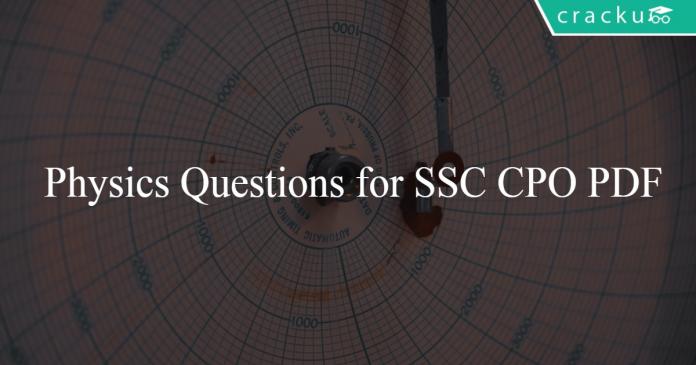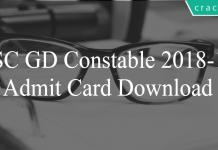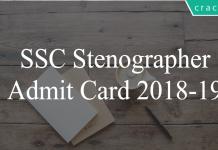Physics Questions for SSC CPO PDF
Download SSC CPO Physics questions with answers PDF based on previous papers very useful for SSC CPO exams. 50 Very important Physics objective questions (MCQ’s) for SSC exams.
Download Physics Questions for SSC CPO PDF
GET 20 SSC GD MOCK FOR JUST RS. 117
Question 1: A certain house hold has consumed 320 units of energy during a month. How much energy is this in joules?
a) $ 9 \times 10^{8} J $
b) $ 5 \times 10^{8} J $
c) $ 10 \times 10^{5} J $
d) $ 1152 \times 10^{6} J $
Question 2: The pitch of a sound depends on its:
a) frequency
b) amplitude
c) timbre
d) intensity
Question 3: What is the SI unit of electric current?
a) Watts
b) Coulombs
c) Amperes
d) Joules
Question 4: Mechanical energy is equal to:
a) Kinetic energy + Chemical energy
b) Kinetic energy + Potential energy
c) Kinetic energy + Heat energy
d) Kinetic energy + Electrical energy
Question 5: While releasing the arrow from a stretched bow,the PE of the bow is converted into?
a) chemical energy
b) kinetic energy
c) sound energy
d) heat energy
SSC GD CONSTABLE PREVIOUS PAPERS
SSC CHSL PREVIOUS PAPERS DOWNLOAD
Question 6: With a Concave misor(Centre of curvature), when an object is placed at the Focus (F),
which of the following applies for the image?
a) Real, inverted image of the same size at C
b) Real, inverted, diminished image between C and F
c) Real, inverted, highly enlarged imageat infinity
d) Real, inverted, highly diminished image at F
Question 7: What is the physical state of water at $12^\circ$C ?
a) Gas
b) Solid
c) Liquid
d) Ionic
Question 8: Which of the following are bad conductors of electricity?
A) Mica and Quartz
B) Metals and Rubber
C) Metals and Mica
a) A and B only
b) A and C only
c) B and C only
d) A only
Question 9: In a hydro-electric power station ultimately which energy is converted into electrical
energy?
a) Mechanical energy
b) Potential energy
c) Heat energy
d) Kinetic energy
Question 10: Work doneby an object on application of a force would be zero if the displacement of the
object is:
a) negative
b) positive
c) neutral
d) Zero
18000+ Questions – Free SSC Study Material
Question 11: A conductor having some appreciable resistance is called a:
a) Resistor
b) Insulator
c) Conductor
d) Semi-conductor
Question 12: What is the principal focus of a spherical mirror?
a) It is a point from which the rays of light appear to be coming from onthe principal axis of
a convex mirror.
b) It is the point on theprincipal axis through whichraysof light parallel to the principal axis
pass after reflection or appear to be arising from this point on the principal axis.
c) It is the centre of a hollow sphere of which the spherical mirroris a part.
d) It is the midpoint of a spherical mirror.
Question 13: The SI unit of electric current is:
a) milliampere
b) volt
c) microampere
d) ampere
Question 14: One nanometer is:
a) $10^{-11} m$
b) $10^{-10} m$
c) $10^{-8} m$
d) $10^{-9} m$
Question 15: Which of the following is NOT a renewable source of energy?
a) Wind energy
b) Geothermal energy
c) Energy from fossils
d) Solar energy
Question 16: What does the kinetic energy (KE) of a moving body depend upon?
a) Mass and its position
b) Weight and its position
c) Mass and acceleration
d) Mass and velocity
Question 17: Which of the following can neither be created nor be destroyed?
a) Velocity
b) Power
c) Energy
d) Momentum
Question 18: Which of the following processes will take place the slowest for the same quantity of
liquid?
a) Boiling
b) Condensation
c) Evaporation
d) Freezing
Question 19: If the kinetic energy of a body becomes 256 times its initial value, then the new linear
momentum will be:
a) 8 times the initial value
b) 16 timesthe initial value
c) the same as the initial value
d) 32 times the initial value
Question 20: An Odometer is an instrument used to measure ………. in automobiles.
a) direction
b) distance
c) odour
d) speed
Question 21: The given symbol stands for a/an ……… in an electric circuit.

a) resistor
b) plug key
c) electric bulb
d) battery
Question 22: Which of the following devices helps to maintain a potential difference across a conductor?
a) Galvanometer
b) Ammeter
c) Voltmeter
d) A cell or battery
Question 23: Which of the following instruments is used to measure electric current?
a) Rheostat
b) Voltmeter
c) Ammeter
d) Galvanometer
Question 24: When bullet is fired from a gun, the gun moves in the opposite direction. This illustrates
Newton’s:
a) third law of motion
b) first and second law of motion
c) first law of motion
d) second law of motion
Question 25: If the power of a corrective lens is +2.0D,then it is a:
a) convex lens
b) concave lens
c) convex mirror
d) concave mirror
1500+ Free SSC Questions & Answers
Question 26: The work done in one complete revolution of the moon aroundthe earth is equal to:
a) centripetal force $\times$ radius of the orbit of the moon
b) gravitational force $\times$ circumference of the orbit of the moon
c) gravitational force $\times$ diameter of the orbit of the moon
d) Zero
Question 27: What does Coulomb’s Lawstate?
a) The magnitude of the forceof attraction (or repulsion) between twopoint chargesis inversely proportional to the product of the quantity of the two charges as well as to the square ofthe distance between them.
b) The magnitude of the force of attraction (or repulsion) between two point chargesis directly proportional to the product of the quantity of the two charges and inversely proportional to the square of the distance between them.
c) The magnitudeofthe forceofattraction (or repulsion) between two point chargesis inversely proportional to the product of the quantity of the two charges and directly proportionalto the square ofthe distance between them.
d) The magnitudeofthe force ofattraction (or repulsion) between two point chargesis directly proportional to the product of the quantity of the two charges and to the square of the distance between them.
Question 28: Which of the following scientists gave the law that governs the force of attraction/repulsion between two charged particles?
a) Charles Dufay
b) Michael Faraday
c) Archimedes
d) Charles Coulomb
Question 29: The pitch of a sound depends on its ……….
a) frequency
b) wavelength
c) amplitude
d) timbre
Question 30: The tendency of undisturbed objects to stay at rest or to keep moving with the same
velocity is called
a) inertia
b) momentum
c) energy
d) force
100+ Free GK Tests for SSC Exams
Question 31: The resistance of a conductor is inversely proportional to its:
a) length
b) resistivity
c) temperature
d) area of cross section
Question 32: Negative acceleration is in the opposite direction of:
a) force
b) distance
c) velocity
d) momentum
Question 33: Momentum is measured as the product of:
a) Mass and inertia
b) Mass and force
c) Mass and velocity
d) Mass and acceleration
Question 34: A seesaw is an example of which concept of physics?
a) Current
b) Time
c) Electricity
d) Force
Question 35: We can compare electric current in a conductor to:
a) a bus ride ina city
b) people walking in street
c) an inter-city train ride
d) water currentin rivers
Question 36: The ……… between two bodies are always equal and opposite.
a) inertia
b) forces
c) pressure
d) momentum
Question 37: Which of the following is NOT an example of non-uniform motion?
a) A man running a 800 m race
b) The rotation of the blades of a ceiling fan
c) A car moving on a crowded street
d) A person jogging in a park
Question 38: What is ‘amu’ in the context of atoms and molecules?
a) Avegadro Mass Unit
b) Atomic Unified Mass Unit
c) Atomic Mass Unit
d) Atomic Molecule Unit
Question 39: Which of the following lies on the reflecting surface of the mirror?
a) Centre of curvature
b) Focus
c) Pole
d) Focal length
Question 40: The point at which all rays converge is termed as ………
a) principle axis
b) pole
c) aperture
d) focus
Question 41: 1kWH = ………J
a) $3.6 \times 10^{-8}$
b) $3.6 \times 10^{-6}$
c) $3.6 \times 10^{8}$
d) $3.6 \times 10^{6}$ J
Question 42: An object of 10 kg is moving with a speed of 2 m/s. The kinetic energy of the object is:
a) 20 J
b) 5 J
c) 10 J
d) 40 J
Question 43: An object travels 23 m in 3 s and then another 15 m in 2 s. What is the average speed of the object?
a) 7.6 $ms^{-1}$
b) 7.6 $s^{-1}$
c) 8.0 $ms^{-1}$
d) 7.6 $m$
Question 44: A car accelerates uniformly from 18 $kmh^{-1}$ to 72 $kmh^{-1}$ in 5 s. The acceleration of the car is:
a) 3 $ms^2$
b) 10.8 $ms^{-2}$
c) 10.8 $ms^2$
d) 3 $ms^{-2}$
Question 45: Which of the following physical quantities has no unit?
a) Momentum
b) Density
c) Pressure
d) Relative density
Question 46: Weight of a body is maximum at the:
a) Equator
b) Pole
c) Subtropics
d) Tropics
Question 47: Momentum = …………..?
a) Mass $\times$ Acceleration
b) Mass / Volume
c) Mass $\times$ Velocity
d) Mass $\times$ Density
Question 48: Who demonstrated that objects of different masses would reach the ground together when dropped from the same height?
a) Isaac Newton
b) Archimedes
c) Robert Boyle
d) Galileo Galilei
Question 49: In the figure given below, if an object is moved from A to B (consider the height of AB=h), in which situation the work done on the object is mgt?

a) In path 1
b) Both path 1 and 2
c) In path 2
d) Neither path 1 nor path 2
Question 50: Which of the following sets are the best insulators?
a) Rubber, glass, plastics, ebonite, cotton, copper
b) Bakelite, dry air, paper, ebonite, aluminium
c) Plastics, ebonite, paper, cotton, Bakelite, dry air, rubber
d) Silver, copper, gold, iron
Download Current Affairs Questions & Answers PDF
Answers & Solutions:
1) Answer (D)
2) Answer (A)
3) Answer (C)
4) Answer (B)
5) Answer (B)
6) Answer (C)
7) Answer (C)
8) Answer (D)
9) Answer (D)
10) Answer (D)
11) Answer (A)
12) Answer (B)
13) Answer (D)
14) Answer (D)
15) Answer (C)
16) Answer (D)
17) Answer (C)
18) Answer (C)
19) Answer (B)
20) Answer (B)
21) Answer (C)
22) Answer (D)
23) Answer (C)
24) Answer (A)
25) Answer (A)
26) Answer (D)
27) Answer (B)
28) Answer (D)
29) Answer (A)
30) Answer (A)
31) Answer (D)
32) Answer (C)
33) Answer (C)
34) Answer (D)
35) Answer (D)
36) Answer (B)
37) Answer (A)
38) Answer (C)
39) Answer (C)
40) Answer (D)
41) Answer (D)
42) Answer (A)
43) Answer (A)
44) Answer (D)
45) Answer (D)
46) Answer (B)
47) Answer (C)
48) Answer (D)
49) Answer (B)
50) Answer (C)
Download SSC GD Previous Papers PDF
DOWNLOAD APP FOR SSC FREE MOCKS
We hope this Physics questions for SSC CPO Exam will be highly useful for your preparation.





